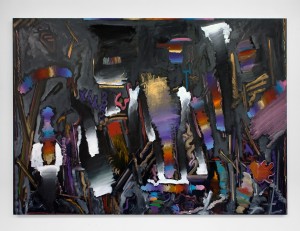Painting a Colorful Reality with Lori Hyland
GALO: You have quite the expertise in art education. You attended the prestigious Pratt Institute in New York as well as The School of Visual Arts. But your education didn’t end there – you also studied with Japanese artist Koho Sensei. Tell us a bit about your training with her.
LH: Koho Sensei was Japanese-American. During the Second World War, all citizens of Japanese ancestry were dislocated from their homes and businesses (many whom resided in the U.S. for generations), and [were] sent to internment camps in isolated areas of the U.S. away from the west coast. Among the many learned and accomplished refugees was an expert in Sumi-E (a traditional form of Asian calligraphy and brush stroke). He taught her and he became an expert and taught for decades in N.Y. I was forced to draw bamboo for six months, until one day, students were allowed to work in any method of our choosing. At the conclusion of our lesson, I was given permission to become an abstract painter, which I have obviously honored.
GALO: I believe you had a hard time drawing in some of your classes when you went back to school to gain a foundation in art – you struggled as those around you whimsically, and without effort, applied vision to paper?
LH: Quite true that drawing was definitely a struggle while others around me worked with ease and facility. I worked my way through the first year of life drawing; learned and, at the end of the game, became somewhat proficient with drawing the human figure, but certainly not great. Incidentally, the worst students were the doctors. Medical anatomy is quite different than artistic anatomy.
GALO: You mentioned that though they excelled in their replication of the models, there was little to no passion in their work. Do you feel that an artist must bring their emotions into a painting in order for it to resonate in vivacity and veracity?
LH: The answer for me is quite simple. Do you want a technically perfect rendering or a piece of work imbued with emotion and vision? We as artists should not be striving for “technical perfection,” but hopefully, for that moment of discovery after countless hours of struggle and investigation.
GALO: A lot of your jazz vision paintings such as Jazz Improv or Gospel/Harlem with their multicolored geometrical shapes, if looked upon closely, resemble those of instruments. In Jazz Improv for instance, there seem to be guitar frets sticking out, while in the Gospel/Harlem painting in the left corner there is an existence of what resembles a tambourine. Was this done intentionally?
LH: It is not intentionally done – we all know of these instruments; [they’re] a part of our culture. Artifacts appear randomly in the proper context such as a work of art centered on music of a certain genre.
GALO: You use an array of colors in most of your paintings. What is the reason for your choice of such a diverse color palette?
LH: No reason — as much else in my work, it appears and it is quite unconscious. That is not to say that I don’t make choices along the way. I most definitely do. Usually, to correct a palette that is not visually appealing to me.
GALO: On your site you write that a great deal of your inspirations came from your travels in France. What specifically inspired you there – was it the food, the sites, the culture, or perhaps the language and the people?
LH: The Gothic Cathedral, built millennia ago and maintaining a perfect integrity of spirit and wonders that to this day are architecturally, aesthetically, and scientifically complete. I find nothing in the western world as inspiring. I am ever mindful of their power that has greatly influenced my work.
GALO: I think in a previous interview you mentioned you would never paint the external world, yet you have a whole series entitled Nature. Isn’t that a bit contradictory?
LH: Nature, as all else, is filtered through my vision and sensibilities.
GALO: Why is it of utmost importance to you to do something that no one has done before in terms of subject matter in art?
LH: That is not exactly true. I look at lots of artists’ work, and inevitably, when it comes to painting, it comes down to my vision – it just happens that way and many of us may be influenced by the same theme. For example, Jazz, with each one of us has a unique interpretation.
(Article continued on next page)

